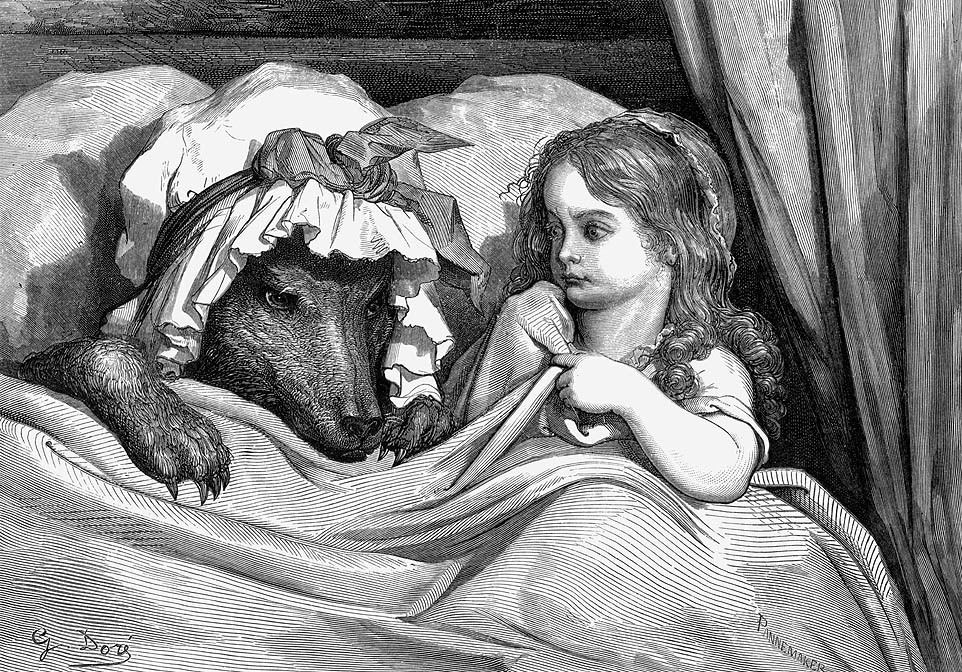
Illustration by Gustave Doré, 1862
{Image description: Illustration in black and white. In a bed, the wolf lies on the left side with the grandmother's night cap on. On the right lies the young girl, visibly scared and pulling the covers as if to hide from the menacing presence on her side.}
*
The tale of the little girl who dresses in red and seduces an evil wolf is, for me, inseparable from the sign of Scorpio. This is the sign of passion, desire, and control (of oneself and of others), but also of death, transformation, and all that is secret.
The oldest version that has come down to us, The Grandmother's Tale, comes directly from oral tradition and begins as we all know it, with the little girl who goes to visit her grandmother. However, this little girl does not yet have the attribute that characterizes her today, her little red capuchin, given to her by her grandmother. The detail of the red bonnet is added by Charles Perrault and hides an important part of the original narrative.
The transformation process of the girl into a woman, which we will see later, and which is the main purpose of the tale in its oral tradition version, is eliminated by Perrault to make his version of the tale more proper for the Parisian salons of Louis XIV's court. Red being a color associated with sexuality, blood and sin, and associated with Mars, the planet of sexuality, assertion and aggressiveness.
This detail adds to the protagonist, since the beginning of the story, the status of a young woman (menstruating), who has already lost her childhood innocence and who carries with her the potential guilt of the original sin, which all women carry (yes, even today), without confronting the audience with this "unpleasant" process during the course of the narrative.
In the Grandma's Tale, the girl meets the wolf (in some versions a werewolf, in others an ogre) who asks her where she is going. Although this encounter already initiates a certain tension, there is no sexual or confrontational atmosphere yet. But in both Perrault's Little Red Riding Hood and the Brothers Grimm's the seduction begins here.
The young girl, not only reveals to the wolf where her grandmother lives, but even lengthens her walk and allows him to get to the old lady's house before her, thus adding a few more ounces of guilt to the burden she is carrying since the beginning of the story for the simple fact that she is already a woman.
In the collective unconscious, the wolf that crosses the girl's path symbolizes our wild, instinctive and impulsive nature, ruled by Mars. And also that which scares us and makes us afraid, what is hidden in the shadows and that we can't control, ruled by Pluto, the two planets with affinity with Scorpio. The wolf is everything we keep in the 8th house, the house of crisis and connected to the same sign, where we hide our drives, instincts and desires, which we can eventually sublimate.
When the wolf arrives at the grandmother's house, the oral version of the narrative definitively enters into Scorpionic territory, not advised for more sensitive spirits. The wolf devours the grandmother and keeps a piece of her flesh in the pantry and some of her blood in a bottle. When the girl arrives, the wolf, pretending to be the old lady, offers her meat and wine, which she naively accepts.
Although morbid and repugnant — forbidden, unacceptable and very plutonic — this is the moment when the transformation of the girl into a woman takes place, the one that Charles Perrault deleted in his reinterpretation and that the Brothers Grimm kept omitted. This is the passing of testimony from one generation to another. The grandmother passes on her feminine wisdom to her young granddaughter and gives her her place in the circle of Eve, Aphrodite and Persephone.
In this very relevant act is implicit the deepest symbolism of Scorpio: it is necessary to let go of what is dying so that something new, fresh and invigorated can be born in its place. And it is precisely this transformation that is overturned by Charles Perrault and the Brothers Grimm, who also take a plutonic role themselves by sanitizing the tale, annihilating that which is inconvenient and inadequate for them.
The sexual tension, so characteristic of Scorpio, intensifies when the wolf, still in the guise of the granny, invites the young girl to lie down with him. Before doing so, she offers him a moment loaded with eroticism, in a scene that is practically a striptease session. The young girl takes off her apron and asks the wolf where she puts it, and the wolf replies "Put it on the fireplace, you won't need it anymore"; she takes off her bodice and asks the same thing, and the wolf replies "Put it on the fireplace, you won't need it anymore", and this conversation is repeated with each of the piece of clothing. After this sensuality-laden dialogue, the girl gets into bed and then ensues the famous conversation that ends with the line "The better to eat you with!"
This point is the climax of the narrative, which reaches an intense atmosphere full of controlled and veiled sexual energy. But the wolf, willing or not, is about to lose control of his violent, primitive impulses and at this point in the story the girl/woman is called upon to confront her hidden, scorpionic Mars, her own sexual desires and instincts projected onto the wolf. In the Perrault and Grimm versions, Little Red Riding Hood is subdued and dominated (swallowed) by them, personified in the wolf.
In Charles Perrault's tale the narrative ends here and he adds a moral in which he warns the girls not to listen to strangers, making it clear that all that has happened was the young girl's fault, and without giving her a chance for redemption or salvation. The Grimm brothers, authors of the version best known today, introduce here a new character, the hunter, who appears, somewhat artificially, right at the end of the story only to rescue the women from the wolf's belly, unable as they are to defend themselves.
But, in The Grandmother's Tale, when the moment "The better to eat you with!" comes, the young woman realizes that it is not her grandmother she is lying with after all, and to escape she uses the same strategy that the wolf used to bring her here, manipulation. She tells the wolf that she needs to relieve herself and that she has to go outside. At first the wolf denies her request, but she insists. The wolf then ties a string around her foot so that she won't run away, but she ties the string to a plum tree and thus evades his control, escaping back home.
This version recognizes the young girl’s ability to recognize that she is not yet ready for this moment and gives her the possibility to decide on her own destiny. It is she who, all by herself, puts an end to the situation, revealing herself to be autonomous and independent, without the need for a man to save her, nor being at the mercy of other people's instincts or desires.
Subject of many versions and adaptations, this is a story that teaches young girls how to deal with the Scorpionic side of life, sexuality, desire and control, the processes of death and rebirth, and the intense and deep power that all this energy carries.
My favorite and, in my opinion, the most integrative version of this theme is Angela Carter's short story The Company of Wolves, published along with other short stories in 1979. In this story the protagonist seduces the wolf without fear and consciously gives herself to him, appropriating his desire and assuming her own wild side, her sexuality. The tale ends with this sentence: "See! Sweet and sound she sleeps in granny's bed, between the paws of the tender wolf."
